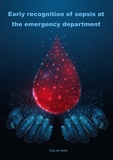Early recognition of sepsis at the emergency department

Hond, Titus de
- Promoter:
- Prof. dr. H.A.H. (Karin) Kaasjager
- Co-promoter:
- Dr. J.J. (Jan Jelrik) Oosterheert
- Research group:
- Oosterheert
- Date:
- July 6, 2023
- Time:
- 10:15 h
Summary
Sepsis is a clinical condition in which an infection causes organ damage. This organ damage is caused by an excessive response of the immune system. Globally, sepsis incidence rates are estimated at 50 million people and approximately 11 million deaths are sepsis-related annually. Early recognition of sepsis is known to improve outcome rates. Nonetheless, early recognition of sepsis is challenging due to the heterogeneous presentation of sepsis patients. Patients often have non-specific clinical signs and frequently lack signs of a potentially life-threatening disease.
This thesis contains three parts that discuss several topics concerning early recognition of sepsis at the emergency department. First, several issues concerning heterogeneity within sepsis studies are discussed. Unfortunately, it is hard to define sepsis at the emergency department, resulting in varying definitions. Depending on the chosen definition of sepsis incidence rates differ significantly, which hampers study comparison and generalizability. Second, several innovative biomarkers to diagnose sepsis are investigated. Unfortunately, it is likely that the perfect sepsis biomarker doesn’t exist, although some biomarkers show increased clinical value compared to the currently used markers such as CRP and white blood cell count. The last part involves research on the value of artificial intelligence and machine learning to diagnose sepsis in an early phase. We show that machine learning is able to identify unique patient clusters which might enable a more personal approach. Also, machine learning algorithms could be used to identify new diagnostic tools.